There seems to be some major misconceptions on how a two stroke engine works and how maximum power is made. Additionally, the two stroke exhaust system has its own
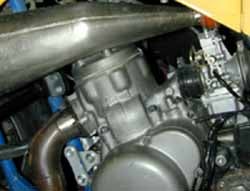 |
|
Two Stroke
engines are very popular. This one has a displacement of 250cc. |
Hopefully, when all is said and done, you will be the master of two stroke knowledge at your next bull session with the gang. It took some convincing (I argue with myself all the time) for me to do this article. My biggest fear was being spammed with e-mail by self proclaimed two-stroke experts lambasting me as to what they feel is incorrect information. So if you are an expert please try and bear with the rest of us!
Class is in session! Let's start with the basics, the difference between two strokes and four strokes and why they are called that in the first place. The word "stroke" refers to the movement of the piston in the cylinder. Moving from bottom dead center (BDC) to top dead center (TDC) is one stroke. Every time the piston moves from one extreme to the other it is considered a "stroke".
In a two stroke engine it takes two strokes (up and down) to complete the cycle and have everything start over again. A four stroke engine requires four strokes (up and down,up and down) to complete the cycle. So now that we understand the term "stroke" we can move on to other terms like intake, exhaust, transfer,scavenge and boost ports. Not to mention exhaust shock wave and pipe timing. Intake and exhaust ports are just that.
The fresh fuel/air charge enters via the intake port and exhaust exits out
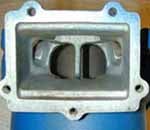 |
| View of intake port |
The simplest of two strokes only have an intake and exhaust port. More exotic two strokes have several ports in addition to intake and exhaust. One statement I have heard is "It's a two stroke it aint got no valves!". Well there is two things I would like to say to that.
First, Hooked on Phonics? And second, Bull-pucky! Two strokes have valves (now listen up junior, I'm talkin' to you!) the piston is one and the reeds are the other. Piston? Yep that's right. The piston not only serves as, well...the piston but it is also the intake and the exhaust valve all in one. Ahh...I can hear you now..."that Dave needs to get off the Nyquil and get a grip."
Well I am not looped on cough syrup and I can prove it. I need to finish with my basic introduction so everything will make sense and then I will get to it. Reeds. Why are they called that, what are they, and what do they do? Although I have never seen an actual "reed" reed valve, I am told they are made of a reed material similar to that in your basic reed instrument.
So if you
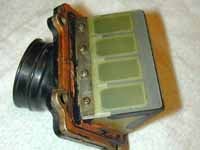 |
| Reed Block and Reeds |
Modern reeds are more space age. Materials like carbon fiber and high strength polymers are typically used. The reed valves serve to open and close the pathway into the engine allowing the fresh fuel/air mixture to enter the case of the engine and trap it.
They act like a check valve. Fuel/air gets in but the only way out is through the engine. The design of the reeds and the reed box can drastically affect the performance of the engine. That is why aftermarket reeds and reed boxes are a very popular upgrade. Simple to install and very effective. I would be remiss if I did not mention the rotary intake valve.
Although these types of valves are not used on our motorcycle type engines they are wildly popular with the personal water craft crowd. Every SEA DOO on the planet uses rotary valve induction.
This type of valving works extremely well but is more complicated to implement. If you
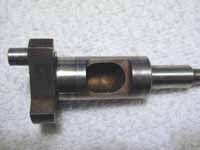 |
| This is a model aircraft crank/rotary valve. |
The valve is part of the crank on a model aircraft engine and intake gasses flow through the hollow crankshaft. On a Rotax engine (like those found in a SEA DOO) the rotary valve is a plate that rotates on a splined shaft geared to the engine. As this plate rotates it covers and uncovers the intake port.
Like I said, this is a more complex arrangement to implement. In the next few paragraphs I will describe the events that take place during the operation of a two stoker. Many things are happening at the same time but I am only able to describe them one at a time. So if after you read my description of operation it sounds like gibberish, read it a second time and it might make more sense to you. Ok,so how does all this work? Read on and I will tell ya.
Here's how a basic two stroke works. We will start with the piston at bottom dead center (BDC). As the piston moves up it creates a low pressure area behind the piston. Because the pressure in the case is now lower than the ambient (the air outside of the engine) air rushes into the engine through the carburetor past the reed valve and floods the crank case with a fresh fuel/air charge.
Once the piston reaches top dead
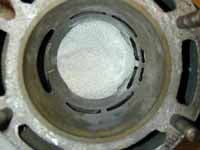 |
|
A view
down a cylinder. The exhaust port is on the left. |
As the piston moves down pressure is increased until (now pay attention here as this gets tricky) the top of the piston drops below the top of the intake port(window). Once the piston uncovers the intake port the pressurized fuel/air charge rushes into the combustion chamber. When the piston reaches BDC and starts on its way back up compression begins. As the piston moves up it eventually covers both the intake and exhaust ports.
Pressure really starts to build now and at a predetermined point the spark plug fires and sends the piston rocketing down to do it all over again. As the piston is moving back down it uncovers the exhaust port before the intake so the burnt fuel/air mixture will go out the exhaust port and not back through the intake port and into the engine.
The exhaust gets a little help leaving the engine from the fresh fuel/air charge once the piston uncovers the intake port and the pressurized fuel/air rushes in. In fact the fresh fuel/air charge enters with such pressure that it forces all of the remaining exhaust gasses out and some of the fresh fuel/air charge ends up leaving too.
All of this happens many thousands of times a
minute. Whew! In a nut shell it looks like this:
1: Piston moves from BDC to TDC creating a low pressure area in the
crankcase.
2: Because of the vacuum in the crankcase fuel/air is sucked in
through the carburetor and past the reed valve assembly.
3: Piston moves down from TDC to BDC.
Reed valve closes causing the
pressure to build in the crankcase.
4: Piston uncovers intake port and pressurized
fuel/air rushes into combustion chamber.
5: Piston now moves up from BDC to TDC completing one cycle and
starting an other. On its way up it compresses the fuel/air that is in the combustion
chamber while at the same time creates a low pressure area in
the crankcase. (see step 1)
6: Spark plug fires and ignites the compressed fuel/air in the
combustion chamber sending piston back down towards BDC.
7: Piston uncovers exhaust port and allows the burnt fuel/air to
escape. Further in its downward travel it uncovers the intake port
and fresh fuel/air rushes in and helps to purge the remaining
exhaust gasses.
(see step 4)
At this point everything starts again at step 1. OK. Now that you
have the basics we can look at some other factors in the operation
of a two cycle engine. One of the biggest external forces acting on
a two cycle is how much oil is added to the fuel. The premix ratio.
Ever change the oil on your two stroke? Of course not! No oil to
change. But how is the engine lubricated? With the oil in the
fuel,that's how!
When the fuel/oil/air charge enters the crankcase everything receives a coating of oil. A very light coating no doubt, but it happens five thousand plus times a minute. One other thing to think about is in a wet sump engine, like a basic four cycle engine, is the oil gets very hot as the engine operates. On a two
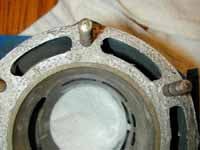 |
|
Some
engines are water cooled. Here is a view of the water jacket. The ports that surround the top are for water. |
Because the Primary function of oil is to cool the engine this arrangement works out very well. Of course running too lean by not mixing the fuel and oil at the correct ratio or by incorrect jetting in the carburetor can have some fairly negative results. We could have an entire discussion about fuel/oil ratios and carburetor jetting but we will leave that for another time. Before I move on to exhaust pipes here is one more thing for you to think about.
Valve timing and duration. In a four stroke the valve timing and duration is controlled by the cam shaft. The shape of the cam lobe (cam profile) determines how fast and how long a valve stays open. Cam timing determines when the valve will open. That is why aligning the timing marks on the cam gear is so important. But a two stroker has no cam so how is the valve or port timing and duration set?
Easy, the height of the window or port determines the timing when that port will be open and by default determine the duration. As a very basic example, lets start with the piston at TDC or zero degrees. As the piston moves down at a certain point the top of the piston uncovers the very top most edge of the exhaust window. At this exact position, say 85 degrees ATDC (after top dead center) is the timing point at which the exhaust valve is open. As the piston continues to move downward, pass through BDC and starts moving upward it begins to close off the exhaust port until at an exact point the port is closed completely.
This point would be 85 degrees BTDC (before top dead center). So By doing the math: 180 degrees minus 85 equals 95 degrees of duration per stroke. Two strokes per cycle so 95 times 2 equals 190 degrees of valve duration. Keep in mind the numbers I am using are to illustrate a point and most likely are way off from actual timing degree numbers used on a production engine. I just used them because they are easy to understand.
From my example you can see that the height of the top of the port determines when the valve opens and ultimately determines the duration. One last thing on valve duration. Two strokes as opposed to four strokes have major valve over-lap. Over-lap is when both valves are open at the same time.
On four strokes there is very little if any over-lap but keep in mind that a two stroke does what a four stroke takes twice as long to accomplish. Finally, let's talk about exhaust pipes. This is where the real power is made in a two stroke. I cannot think of a better way to make more HP in a two stroke engine than by adding a tuned pipe.
Tuned? Like to the key of E? Well as goofy as that sounds it's not far off! Let me explain (even I want to hear me explain this one!) OK, you have probably have heard this example used to demonstrate how sound waves move through air (or water for that matter). The demonstration involves dropping a small stone in a pond and watching the little waves it makes radiate out from the
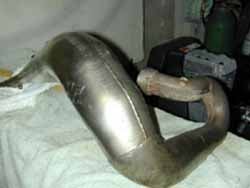 |
|
Two stroke
pipes typically have an expansion chamber like the one shown here. |
The speed that the waves move is called frequency. The higher the frequency the more waves that will pass a given point in a given amount of time. An astute observer will note that when the waves hit something they are reflected off into another direction. What does all of this have to do with two strokes?
EVERYTHING! The reason the pipe is called a tuned pipe is (finally were getting to it!) the length of the pipe is adjusted so when the engine is at the correct speed or RPM it will be on the pipe. Are you totally confused yet? It's like this: when the piston uncovers the exhaust port the hot, burnt exhaust gasses leave with a bang.
This bang crates a shock wave that travels the length of the pipe flowing into the expansion chamber (the expansion chamber helps to pull the exhaust from the engine) until it hits the stinger end of the pipe. Because the pipe is constrictive at the stinger some of the shock wave is reflected back towards the exhaust port. While all of this is happening the engine continues to do its thing. The piston continues to move through it's cycle and as the intake port is uncovered fresh fuel/air rushes in filling the cylinder and helps force the remaining exhaust gasses out. Because the exhaust port is still open and the fresh fuel/air charge is under pressure some of it leaves the cylinder through the exhaust port. At this point the intake port is covered by the piston but the exhaust is still open.
And now the cool part.... while all of this other stuff is happening the exhaust shock wave has made its trip to the end of the pipe and is on its way back to the exhaust port, colliding with the fresh fuel/air mixture that got blown out into the exhaust header. When this collision occurs it forces the fresh fuel/air mixture back into the cylinder. If all of this takes place at the correct instant, just before the top of the piston reaches the top of the exhaust
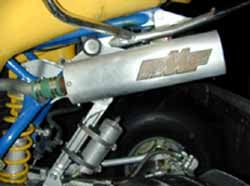 |
|
The
"Stinger" or muffler resides at the end of the pipe. |
It also takes the top of the piston a given amount of time to move down from the point that it uncovers the top of the exhaust port window until it covers it completely on its way up to compression. Because the shock wave travels at the speed of sound (a constant) the only way to change the length of time for the round trip is to lengthen or shorten the pipe. By tuning the length of the pipe to match the timing of the exhaust port and the speed of the engine (RPM,a variable) you can achieve a "super charging" effect.
And BAMO! Instant power! Ever hear the term "Power Band"? Well now you know what it means. Because you cannot change the length of the pipe or the amount of time the exhaust window is open while you are riding the only variable you have to work with is RPM. When the RPM is correct for the port timing and pipe length you will be in the power band!
On some high HP quads its more like the jump to light speed! Nonetheless, I hope you get the idea. There is ten volumes of information that could be written on pipe theory but frankly I am beginning to feel the edges of my brain! What does all of this mean to you? Probably nothing. Unless you have the means or knowledge to modify and adjust your pipe length or mill the ports in your cylinder this was a information only article.
Fortunately the manufactures of aftermarket parts do have the background and the means to test their theories so when a product comes to market they have made all the mistakes. All you have to do is enjoy! One thing is for sure, if you have read this far you should have a better understanding of two strokes (or a headache!). Now you are ready to leave the gang utterly decimated at your next bull session! Be careful on how much you say or they will accuse you of "reading up on the subject the night before". 'Till next time....
